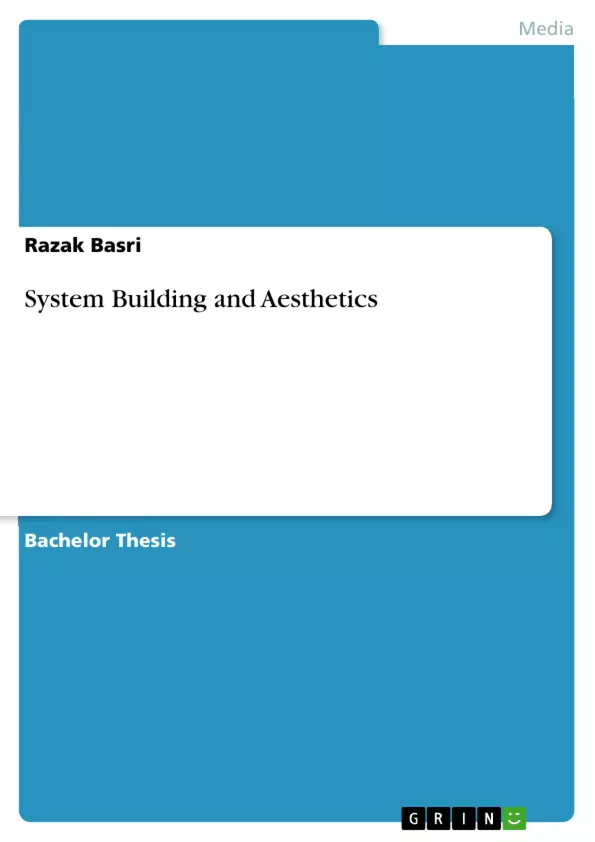The case for System Building Method and aesthetics is often compelling. Building owners are often dissatisfied with their high construction costs and the architects often feel constrained to limit their talent and creativity when confronted with the necessity of adopting System Building Method.
The design of systemised construction buildings need not lead to a monotonous form of architecture. Many of the finest such buildings in Britain are constructed with a high degree of aesthetic value. The design of a systemised building system should also aim to achieve aesthetic value and user satisfaction along with economy of materials, production methods and erection techniques.
Inhaltsverzeichnis (Table of Contents)
- Introduction
- CHAPTER 1 - Historical Review
- 1.1 Outline of historical background
- 1.2 Traditional construction method
- 1.3 Early system building
- 1.4 The birth of prefabrication
- 1.5 Industrial revolution
- 1.6 Scarcity of building materials and labour shortage
- 1.7 Technological novelty
- Summary
- CHAPTER 2. UNDERSTANDING SYSTEM BUILDING
- 2.1 System Building Method
- 2.2 A key to buildability
- 2.3 Criteria for buildability
- 2.3.1 Simplicity
- 2.3.2 Standardization
- 2.3.3 Communication
- 2.4 Principles
- 2.4.1 Tolerances
- 2.4.2 Variety reduction
- 2.5 Importance and relevance of buildability
- 2.5.1 Congestion
- 2.5.2 Technical innovation
- 2.5.3 Labour and availability of skills
- 2.5.4 Mechanization
- 2.5.5 Information
- 2.5.6 System building
- 2.6 Summary
- CHAPTER 3- An Overview of Types of System Building
- 3.1 Prefabrication building
- 3.1.1 Monolithic unit
- 3.1.1a Lightweight units
- 3.1.1b Heavyweight or volumetric components
- 3.1.2 Total System panels
- 3.1.2a open production
- 3.1.2b Closed production
- 3.1.2b Structural systems; frames
- 3.1.1 Monolithic unit
- 3.2 Poured In Situ or Cast in Situ System
- 3.2.1 Total system formwork
- 3.2.2 Climb form
- 3.2.3 Table form
- 3.2.4 Slip form
- 3.2.5 Tunnel form
- 3.3 Components
- 3.4 Summary
- 3.1 Prefabrication building
- CHAPTER 4- AESTHETICS
- 4.1 Place
- 4.2 Subjective matter
- 4.3 Structure
- 4.4 Style
- 4.5 Unity
- 4.6 Scale
- 4.7 Rhythm
- 4.8 Originality
- 4.9 Proportion
- 4.10 Sequence
- 4.11 Composition
- 4.12 Functionalism
- 4.13 Character and honesty
- 4.14 Aesthetic impression
- 4.14.1 Objective and subjective attractiveness
- 4.14.2 Aesthetic balance
- 4.14.3 Design for aesthetic
- 4.15 Summary
- CHAPTER 5- The influence of System Building on Architecture
- 5.1 Modular building system
- 5.2 Uniformity and monotony
- 5.3 Summary
- CHAPTER 6 - Case studies
- 6.1 Case Study 1
- 6.1.1 Superstructure
- 6.2 Case study 2
- 6.2.1 The Montevetro, London
- 6.2.2 Superstructure
- 6.2.3 Description and analysis of case study
- 6.1 Case Study 1
Zielsetzung und Themenschwerpunkte (Objectives and Key Themes)
This dissertation explores the relationship between system building and aesthetics. It aims to examine the historical development of system building and the different methods and types employed. The dissertation also investigates how system building can influence architectural design, particularly in terms of aesthetics and its impact on the overall visual appeal of built structures.
- The historical development of system building methods
- The influence of system building on architectural aesthetics
- The impact of uniformity and monotony in system building
- Case studies analyzing successful and challenging aspects of system building projects
- The role of buildability and its criteria in system building
Zusammenfassung der Kapitel (Chapter Summaries)
Chapter 1 provides a historical overview of system building, tracing its evolution from traditional construction methods to the emergence of prefabrication and industrialization. This chapter delves into key factors that shaped the development of system building, including the scarcity of materials, labor shortages, and technological advancements.
Chapter 2 delves into the core concept of system building, exploring its methodology, key characteristics, and principles. This chapter examines the importance of buildability and its criteria, emphasizing factors such as simplicity, standardization, and communication.
Chapter 3 offers a comprehensive overview of different types of system building, focusing on both prefabrication and in-situ construction methods. This chapter examines various system components, including monolithic units, total system panels, and poured-in-situ systems.
Chapter 4 explores the critical aspect of aesthetics in system building. This chapter examines the subjective nature of aesthetics and its relationship to design elements such as structure, style, unity, and scale. It also explores the concept of functionalism and the importance of character and honesty in achieving aesthetic balance.
Chapter 5 investigates the influence of system building on architectural design, specifically examining the potential for modular building systems and the challenges posed by uniformity and monotony.
Chapter 6 presents case studies of system building projects, analyzing their successes and challenges. This chapter examines the superstructure and design aspects of these projects, providing valuable insights into the practical applications and limitations of system building.
Schlüsselwörter (Keywords)
System building, aesthetics, prefabrication, buildability, standardization, modularity, uniformity, monotony, architectural design, case studies, historical review, construction methods,
- Quote paper
- Dr. Razak Basri (Author), 2006, System Building and Aesthetics, Munich, GRIN Verlag, https://www.grin.com/document/176296



